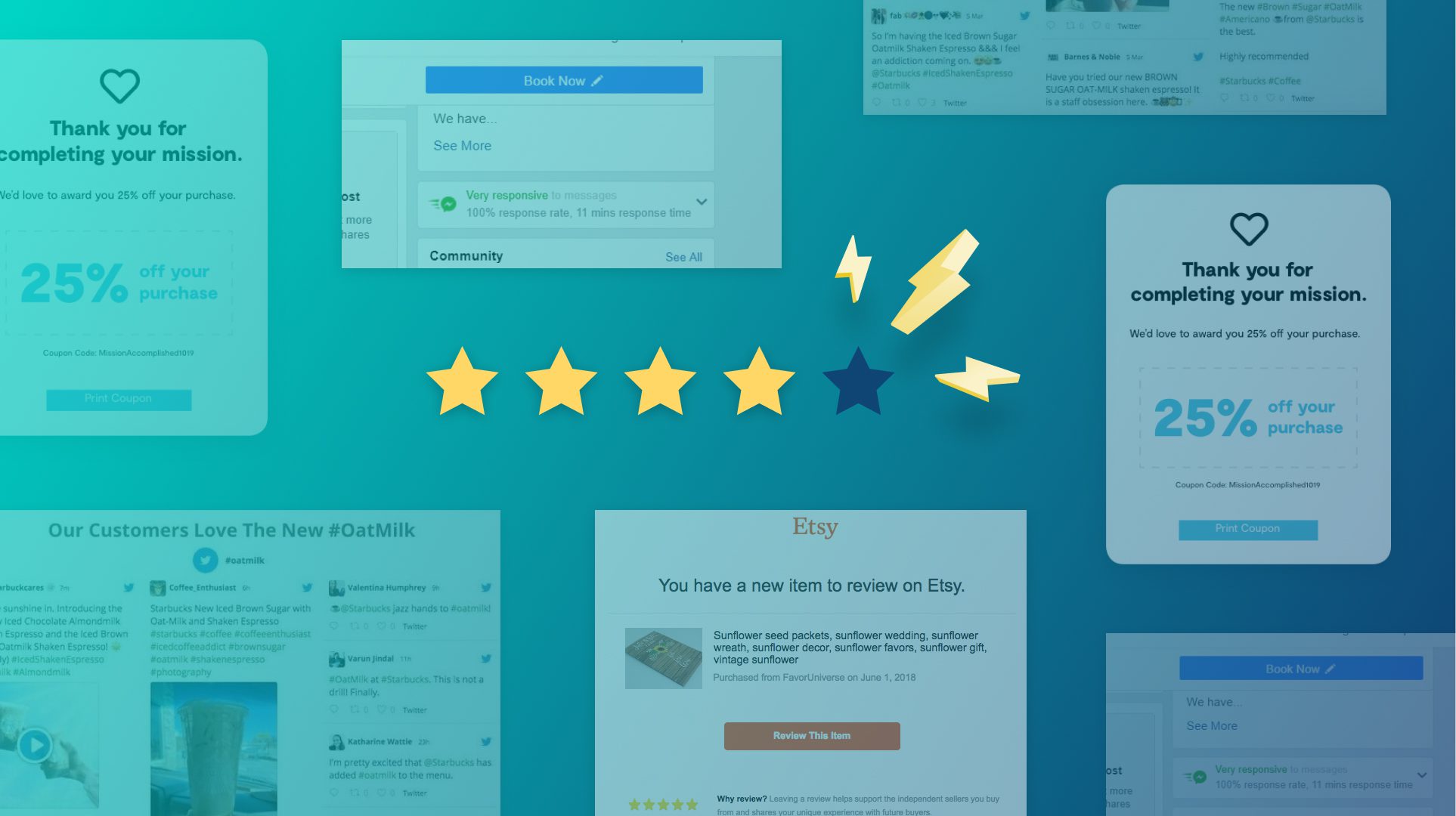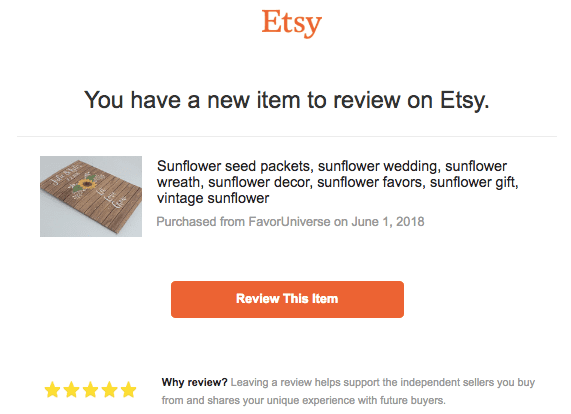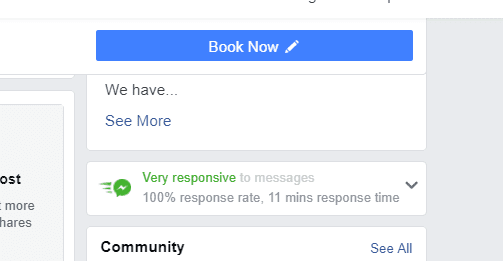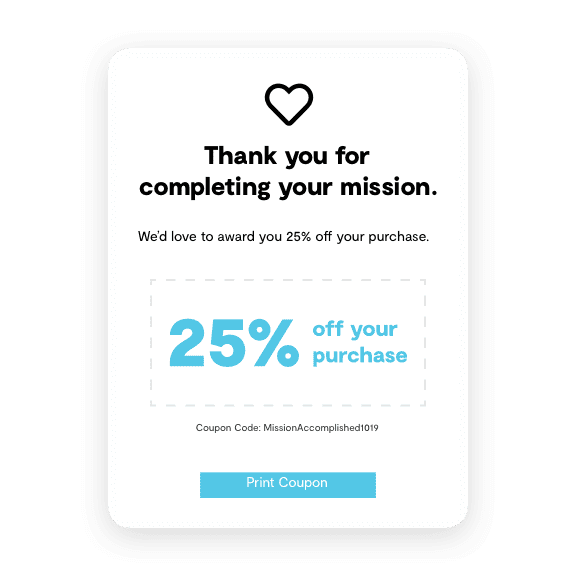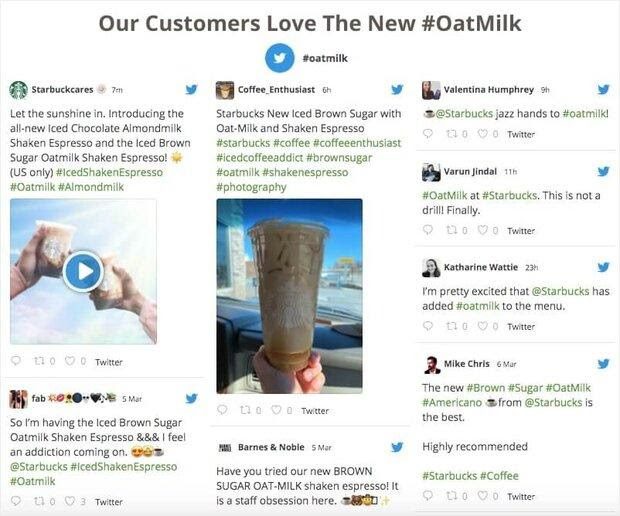According to a recent survey, 79% of consumers trust online reviews as much as personal recommendations.
In other words, product reviews can be as persuasive as a friend, colleague, or family member. That’s pretty persuasive!
So the more reviews, the better. And the better the reviews, the more trust you’ll build.
Thankfully, it’s human nature to want to share our experiences. In fact, the same survey found 72% of customers asked to leave a review will do so.
Of course, there’s a right and wrong way to ask. Do it right, and positive reviews will come rolling in. Do it wrong, and well, you might end up wishing you never asked.
Read on for the seven best ways to get high-quality product reviews, and what to avoid while you’re at it.
1. Send post-purchase interactive AMP emails
The single most effective way to get reviews? Post-purchase review request emails. (Try saying that five times fast!)
Yotpo agrees. According to their research, post-purchase emails have an 8.1% response rate. Not bad when you consider the average CTR on social campaigns is less than 1%.
Plus, that 8.1% can get even better.
Our friends at Yotpo know timing is key. They found emails sent on Saturday morning have a 143% higher conversion rate than ones sent on a busy Thursday afternoon.
Content is also a big part of the equation. It’s no secret, your response rate depends on compelling copywriting and eye-catching design.
But there’s another lesser known factor that can increase conversions: interactivity.
Specifically, AMP emails can turn that 8.1% into a whopping 42.12% response rate.
One SaaS company did an experiment with over 20,000 customers. A generous sample size! The email ask: leave a review.
About half received static HTML emails. This half had to click through to leave a review. The other half received AMP emails with interactive forms, so they could submit a review directly from their inbox.
The result: Compared to static emails, AMP emails had a 5.2x greater response rate.
Clearly, the convenience of AMP emails has a BIG effect on the likelihood of a customer leaving a product review — and the same can be said for many calls to action.
Want to put it to the test? Check out this post to see how to create your own AMP product review email in Dyspatch, no coding required.
“With AMP, brands can stand out in saturated inboxes by eliminating extra clicks or stale content. Customers are 5X more likely to complete product reviews if they can complete the review directly in the email — which makes this a perfect use case.”
— Matt Harris, Co-Founder and CEO of Dyspatch
2. Ask during key moments in the buyer journey
A delivery is late. A product review email goes out anyway. An irritated customer gives your product zero stars as a result.
It happens. But situations like these can be avoided with better timing. By choosing a positive moment in the buyer journey to ask for a review, you’ll increase your odds of success. (And decrease your odds of rubbing customers the wrong way!)
A positive moment could be when your customer receives an order in record time. Or, after they see your product solving a problem for the first time. Hone in on these moments, and you’ll find a goldmine of reviews.
Other ‘golden’ moments in the buyer journey, include:
- After a customer reorders your product
- After a positive interaction with customer service
- After a customer tags your brand in a positive social media post
- After a customer refers someone to you
For example, Etsy asks for a review about a month after you place an order:
This is perfect timing for a retailer like Etsy. Independent artisans and small businesses make and ship most of their products, which can take a little longer. So by making their ask after a month, Etsy gives customers space to try a product and decide whether they like it.
On the other hand, a rapid delivery service like Amazon, would miss their window if they waited a month to ask for a review. The same can be said for a game like Candy Crush that offers instant gratification.
The takeaway? Make your ask at the right moment in your unique buyer journey.
“The best moment to ask for a review? When the customer achieves something of value using your product or service for the first time. For Respona, it’s when they land their first backlink. For Visme, it’s when they complete and publish their first project.”
— Farzad Rashidi, Co-Founder at Respona and Marketing at Visme
3. Use a variety of channels to ask for reviews
It’s true, email is your best bet for reviews. But it doesn’t have to be your only bet.
You can increase your odds of getting a response by using other channels too. After all, some people live on social media, while others love getting good ol’ fashioned mail.
Let’s start with social media. You can learn a lot on these platforms. It’s a natural space for sharing personal experiences — and that includes experiences with products and services.
Watch out for positive posts tagging your product. Spot one? Perfect. Now’s the time to reach out and ask that person to leave a review on your website.
Or, take five-star reviews on your website and promote them through these channels. This provides (literal!) social proof. Plus, it encourages other fans to leave their own testimonials.
“Customers who love you will market for you more powerfully than you can possibly market yourself.”
— Jeanne Bliss, Founder and CEO of Customer Bliss
But even in this day and age, digital isn’t everything. In fact, offline asks can be equally effective.
Here’s an idea: package your products with a hand-written thank you note — review request included. Many customers will be delighted and happy to oblige.
And, of course, the best review requests may not be in writing at all. Train your front-facing team members, like salespeople and customer success reps, to ask for reviews at appropriate moments.
Often, this strategy succeeds. And it makes perfect sense. Verbal feedback is quick to collect. Not to mention, a real human being is much harder to ignore than a digital or analogue ask.
4. Create different spaces for reviews
Like every human being, your customers have preferences and habits. Some may be avid Google reviewers. Others may put their trust exclusively in the Better Business Bureau.
Make sure you cater to these preferences. Collect product reviews in a variety of digital spaces to ensure you reach your audience, everywhere. And boost your response rate by offering customer’s several review platforms to choose from.
Here are some of the most popular review sites for online shoppers:
For an instant SEO boost, claim your company’s page on Google My Business. That way, customers can find you via standard search or in Google Maps.
Google reviews work on a simple five-star rating system — perfect for encouraging quick endorsements. Just be sure you’re monitoring your reviews, responding promptly to negative ones, and reporting fraudulent ones.
Facebook is still one of the most important social media platforms out there — even if your business is B2B. So make sure to claim your company’s Facebook page.
Then, respond promptly to any customer questions or reviews. Facebook will reward you for it. The platform gives you a badge showing how quickly you respond to questions. (Yet another chance to demonstrate your great customer service!)
Better Business Bureau
The Better Business Bureau (BBB) is all about (you guessed it!) encouraging better businesses.
Founded in 1912, this organization’s mission is to “advance marketplace trust”. With their long history and nonprofit status, the BBB is one of the most universally trusted sources for customer reviews in North America.
If your business is based in the U.S., Canada, or Mexico, you should register with the BBB. You can also become accredited to build trust with customers.
G2 / Capterra / TrustRadius
G2, Capterra, and TrustRadius are similar B2B software review sites. They allow businesses to research software solutions, find alternatives, and check out detailed reviews.
But here’s what makes these platforms unique: customers aren’t reading your reviews in isolation. Instead, they’re actively comparing them to other platforms. This makes it doubly important to have strong ratings!
“The more advocates you have, the fewer ads you have to buy.”
– Dharmesh Shah, Founder and CTO of Hubspot
5. Incentivize customers to write product reviews
Give and you will receive.
Try offering an incentive in exchange for reviews. If you’re launching a new product or need to collect reviews quickly, this tactic is especially helpful.
Just remember, you have an ethical obligation to be transparent. Make sure to clearly indicate if you collected a product review through an incentive.
You’ll also want to make sure you follow review guidelines on different platforms. For example, Amazon doesn’t allow brands to offer incentives for reviews. Brands who break this rule risk getting banned by the powers that be.
Here are some review incentive ideas to inspire you:
- Review sweepstakes and giveaways. Who doesn’t want to win a prize? No one. That’s why sweepstakes and giveaways are a great way to incentivize reviews. In fact, Power Reviews found sweepstakes campaigns increased review completion rates by 83%.
- Free shipping. “Free” is one of those words that’s hard to resist. And free shipping, well, we all love that. Offering free shipping can help you get more reviews and encourage repeat purchases. Win, win. (Pro-tip: add urgency by putting an expiry date on your free shipping offer.)
- Discounts and gift cards. Give ‘em a discount, get a review. And a repeat purchase. Worried about margins? No problem, add a minimum purchase amount. You can also make the discount or gift card assignable to someone else. That way, happy customers can pass it along to a friend after leaving a review. Talk about social proof!
6. Use a product sampling program
Maybe your brand is brand new. Maybe you have a product line in its infancy.
Whatever the reason, it may be hard to get the review ball rolling. In these instances, product sampling campaigns are your best friend.
Forget waiting for organic growth and collecting reviews over months and years. With this type of campaign, all you need to do is provide free samples of your product in exchange for reviews. Then, you can collect reviews at record speed.
Better still, your product gets exposure. And those who try it may be tomorrow’s paying customers.
These days, it’s easy too. With the help of product sampling communities like BzzAgent, marketers can share samples with active reviewers and micro-influencers. In turn, these reviewers share their experience with their social media following.
Check out these common use cases:
- New product launches. Build anticipation and buzz for your product launch! By providing free samples and gathering product reviews, you can make sure go to market day is a great day. hyg
- Seasonal products. Fashion moves fast. Blink and a season has passed. That’s why, fashion brands often use sampling campaigns to position their products well before a season starts.
- Niche products. If your target market is narrow, building an organic following can take a while. In these instances, targeted product sampling can help turn *crickets* into customers.
- Low ratings. Bad reviews happen. Even if you have a great product, you may get unlucky with your first few reviews. Now, product sampling can’t guarantee good reviews. But it can rapidly increase your total number of reviews — thus your overall rating.
7. Actively engage with positive and negative reviews
Reviews aren’t just a trophy to display proudly on a shelf. Instead, think of them as a conversation. And the best way to keep the conversation going is to show your customers you’re listening.
When you get great customer feedback, make sure to follow-up. Express your gratitude, ask a question, like the post, or do all of the above. After all, if someone praised you in real life, you wouldn’t just ignore them.
The same goes for bad reviews. It may be unpleasant to respond to these, but it’s even more essential. Just remember, don’t get defensive. Keep it professional, say thank you for the feedback, and let the customer know you’re addressing the issue.
Response time is also key. ReviewTrackers reports 53.3% of customers expect companies to respond to reviews within a week. So take too long to answer a complaint, and you risk aggravating the customer further.
“My advice is to answer every customer, in every channel, every time. This is different from how most businesses interact with customers, especially online, which is to answer some complaints, in some channels, some of the time.”
— Jay Baer, Founder of Convince and Convert
Of course, there may be times when you get spam or defamatory reviews. Most platforms will remove these types of reviews on request. And you‘re well within your rights to remove them from your own site.
But back to the good stuff. Be sure to highlight positive customer experiences too. Many review platforms, like Google, Yelp, and TripAdvisor, allow you to highlight quality reviews. It’s like putting all your first place trophies at the front of the case.
Along the same lines, make your best reviews public. Display them on your product pages, share them on social media, use them as ads… the possibilities are endless.
Tools like Smash Balloon’s Custom Twitter Feed Pro can even automate the process. How? By integrating a live Twitter feed of positive brand mentions on your site:
Get the great reviews you deserve
Reviews speak louder than any copy you can write. That’s how the saying goes, right?
In all seriousness though, 87% of consumers read online reviews. And 96% also read businesses’ responses to reviews. So collecting and managing product reviews is essential for your brand’s reputation and growth. But beyond attracting new business, reviews can also help you retain existing customers by giving them a voice and getting insights into your product performance in return.
Follow the tips in this article to get the great reviews you deserve. If you’re not sure where to start, try testing one tip at a time, like leveraging AMP to add an interactive product review form to your emails.
Implementing AMP for Email doesn’t have to be complicated either. With Dyspatch, you get access to a library of pre-coded interactive email apps, including (you guessed it!) a product review app.
